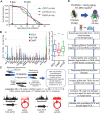Transposable element landscapes in aging Drosophila
- PMID: 35239675
- PMCID: PMC8893327
- DOI: 10.1371/journal.pgen.1010024
Transposable element landscapes in aging Drosophila
Abstract
Genetic mechanisms that repress transposable elements (TEs) in young animals decline during aging, as reflected by increased TE expression in aged animals. Does increased TE expression during aging lead to more genomic TE copies in older animals? To address this question, we quantified TE Landscapes (TLs) via whole genome sequencing of young and aged Drosophila strains of wild-type and mutant backgrounds. We quantified TLs in whole flies and dissected brains and validated the feasibility of our approach in detecting new TE insertions in aging Drosophila genomes when small RNA and RNA interference (RNAi) pathways are compromised. We also describe improved sequencing methods to quantify extra-chromosomal DNA circles (eccDNAs) in Drosophila as an additional source of TE copies that accumulate during aging. Lastly, to combat the natural progression of aging-associated TE expression, we show that knocking down PAF1, a conserved transcription elongation factor that antagonizes RNAi pathways, may bolster suppression of TEs during aging and extend lifespan. Our study suggests that in addition to a possible influence by different genetic backgrounds, small RNA and RNAi mechanisms may mitigate genomic TL expansion despite the increase in TE transcripts during aging.
Conflict of interest statement
The authors have declared that no competing interests exist.
Figures






References
-
- Kaminker JS, Bergman CM, Kronmiller B, Carlson J, Svirskas R, Patel S, et al.. The transposable elements of the Drosophila melanogaster euchromatin: a genomics perspective. Genome biology. 2002;3(12):RESEARCH0084. doi: 10.1186/gb-2002-3-12-research0084 ; PubMed Central PMCID: PMC151186. - DOI - PMC - PubMed
Publication types
MeSH terms
Substances
Grants and funding
LinkOut - more resources
Full Text Sources
Molecular Biology Databases

